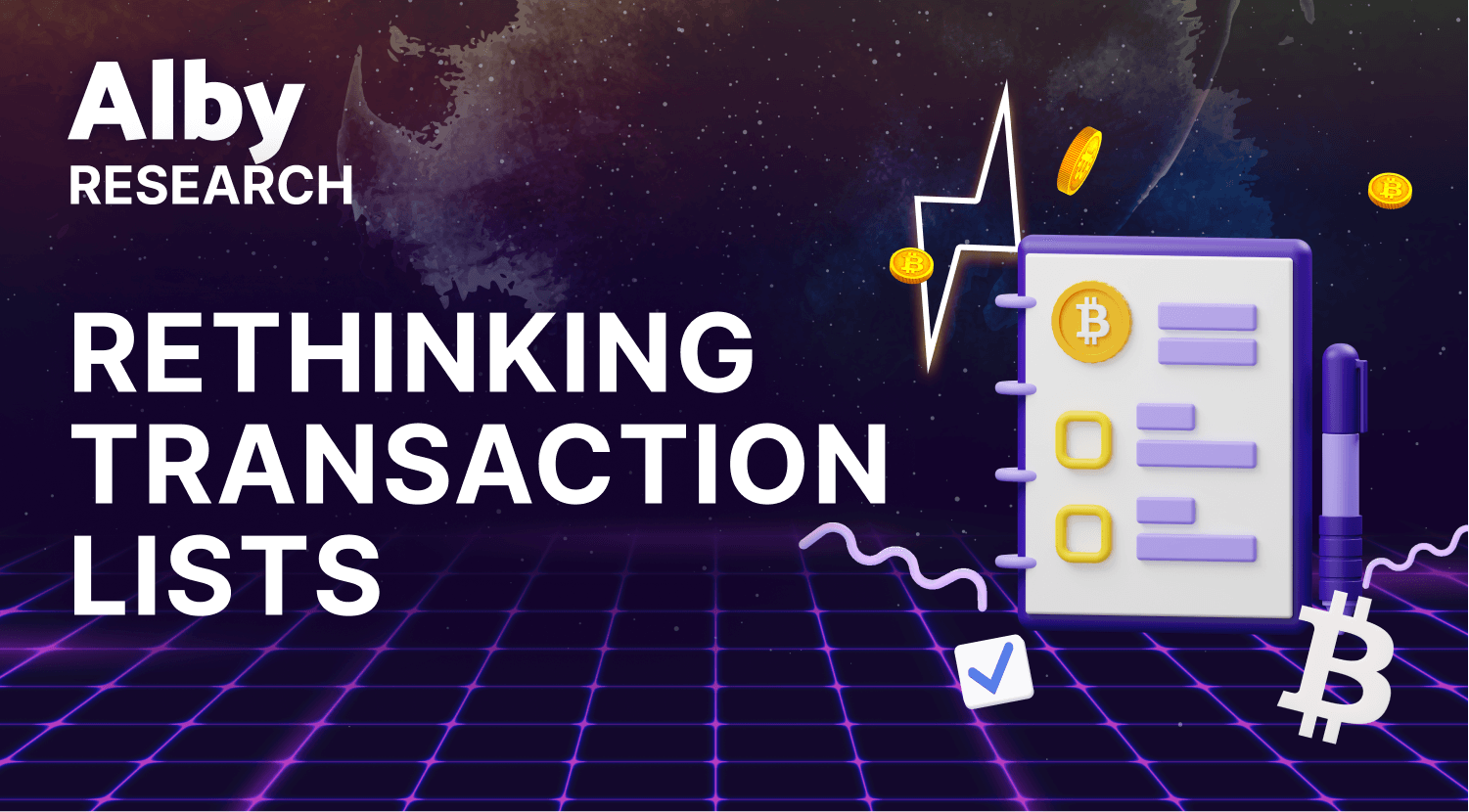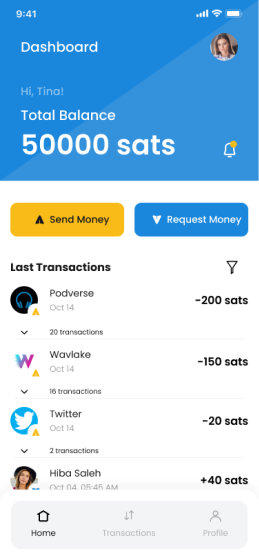Rethinking Transaction Lists

Transaction Lists of Bitcoin wallets permit users to keep track of their payment flows. With the adoption of bitcoin-based micropayments, there is a need to rethink wallet transaction lists to be able to provide an outstanding user experience.
What are Micropayments?
Micropayments are small, usually fixed payments that can be split and assigned to various parties. They’re commonly used in the financial services industry to facilitate transactions involving smaller amounts of money. This system was proposed around the mid to late 1990s and the definition of micropayments has evolved ever since. Older publications defined micropayments as transactions of around $5 to $7. Currently, micropayments are less than a dollar. [1]
Why are micropayment models not widely adopted?
In the older proposed models, micropayments in fiat currency involve 3 parties: the vendor, the consumer and the service provider on which the amount of debit and credit depends on, usually the banking services (centralization). This intermediation adds to the transaction cost, so even if the consumer wants to make a very small payment, the processing cost could be higher than what it is worth. Moreover, any transaction a user has to confirm raises anxiety, “is this worth the pay?”. This is called Mental Transaction Cost and this would always pertain to micropayments. [2]
Since the 1990s, many proposals for micropayment models have been discussed and tested, and every model had drawbacks. Thus micropayment models were rarely adopted.
But Bitcoin's Blockchain technology has the potential to revolutionize micropayments in conjunction with the Lightning Network, a second-layer payment protocol. By providing a decentralized and secure way to send micropayments instantly around the globe, Bitcoin could enable a whole new economy of small digital transactions. [3]
The Bitcoin Lightning Network
Experiments on micropayments since the 1990s have been attempting to aggregate many small payments into fewer, larger payments to reduce the processing cost. Bitcoin is a decentralized payment network and allows a consumer to make close to no-fee transactions through payment channels like the Lightning Network. The Lightning Network is a layer two solution built on top of Bitcoin. It enables off-chain transactions, that is, transactions don’t have to go through the blockchain while still counting on the blockchain security of Bitcoin, thus immensely reducing the fee. A few examples of bitcoin-enabled micropayment websites are Podverse, Wavlake and Stacker News.
Why is the rethinking of transaction lists required?
Coming back to transaction lists, with numerous micropayments happening per session of using a website for example there is an endless list generated filled with transactions. Unpacking and analysing this on a later day is a cumbersome task.

The above screenshots are from the Alby browser extension. This shows an endless list of received micropayments with close to no information about these transactions requiring a redesign of transaction lists.
The process of the redesign
The process started with identifying the end users and understanding their needs. The tools that can help to understand the users are quantitative research methods like surveys and qualitative methods like interviews and contextual inquiries.
Surveys were floated and interviews were conducted with users of digital wallets. The aim of the research was to understand the significance of a transaction list and the current challenges users face while using any cryptocurrency wallet. These are the few questions that were asked to gain the required insights:
- What do you most like about the service that you currently use to make a digital/ online payment?
- Do you go back to the transaction history list for any reason? What are the reasons?
- What are the challenges you face while using the transaction lists?
- Do you understand all the data shown in the transaction list?
- Is there any change in the way, how the data is displayed that would make the list more meaningful for you?
Identified user behavior and challenges
A questionnaire-based survey with 30 respondents yielded the following user behavior:
- 63% of users make bitcoin off-chain/Lightning network transactions
- 30% of users visit the transaction list while calculating expenditure and during the budgeting
- 23% of users visit the transaction list after every transaction they make
Additional interviews generated the following insights:
- The general adoption of the underlying payment system is important when choosing a digital wallet
- The most common use cases are peer-to-peer transfer, purchasing online goods and donations
- Users stick to a Lightning wallet because of the simplicity and intuitiveness of the UI
- Most users rarely visit the transaction list. The most common reason to visit the transaction list is to confirm payment status, budgeting and to analyze payment behavior
- The most common challenges of using transaction lists are navigating through the endless list and finding a particular transaction, unavailable metadata and figuring out who the payment was sent to and why the payment was made.
Exploring solutions
The high amount of transaction list entries makes navigating transaction lists cumbersome.
Case Study:
When Tina listens to podcasts from Podverse and decides to stream payments by the minute. Afterward, she scrolls through Twitter and tips every post she finds interesting. Within a short time, the transaction list expands quickly.
Suggestion: Auto categorization
The transactions are auto-grouped according to the activity and time. This would reduce the clutter of having every transaction in a chronological view. The groups would be summarised properly according to the activity. An additional expanded view gives a detailed list of all transactions made in that category.


Case Study: Tina also finds it quite confusing when she goes back to the transaction list to see the names of websites, while she remembers tipping podcasters for their exciting content. Sometimes she also forgets what she spent all those satoshis for on Twitter
Suggestion: Reflect on actions
The transaction list shows the recipient’s name of the payment. Including the reason for payment. Tina would rather see she tipped 21 sats to Mark whose song she listened to on Wavlake instead of an item about “21 sats sent to Wavlake”. In case this data is not available, a transaction list can provide a mechanism for manual annotation of items in the list.

Case Study: When Tina goes back to find a particular transaction from the list, it is too long to scroll back to the date
Suggestion: Filter/Sorting
Providing date-wise or category-wise filters or sorting mechanisms will make it easier for Tina to find the transaction she needs. The payment status displaying "failed" and "successful" payments can be another category to filter for.
Overall, the user experience always has potential for improvement. The above solutions could be implemented in various forms and visual designs. The focus should be on making it the most simple, intuitive, and convenient while also being transparent to the user. It is great to see that the Bitcoin Design Community is tackling these challenges in its Design Guide.
This research project was conducted by Saranya Satheesh during the Summer of Bitcoin internship with Alby. If you are interested in continuing the research, please reach out to us.
Literature:
[1] Böhle K, Krueger M, Herrmann C, Carat G, Maghiros I (2000) Electronic payment systems – Strategic and technical issues, Background paper Nr. 1 of the EPSO, Institute for Prospective Technological Studies, December 2000
[2] Stanford (2010) Micropayments: A viable business model? Retrieved September, 2022 from https://cs.stanford.edu/people/eroberts/cs181/projects/2010-11/MicropaymentsAndTheNet/issues.html
[3] Poon, J., Dryja, T., (2016) The Bitcoin Lightning Network: Scalable Off-Chain Instant Payments, retrieved Septemeber, 2022 from https://lightning.network/lightning-network-paper.pdf